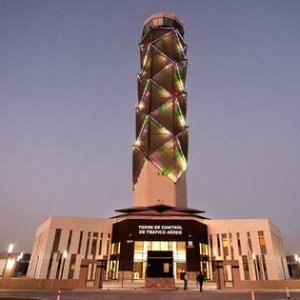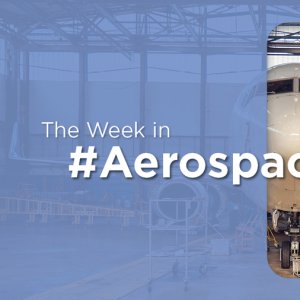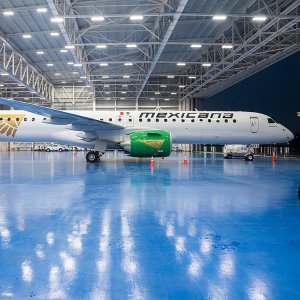
AIFA Going Strong Despite Criticisms
 By Lorenzo Núñez | Livestream Producer -
Mon, 05/24/2021 - 17:33
By Lorenzo Núñez | Livestream Producer -
Mon, 05/24/2021 - 17:33
The new Mexico City International Airport Felipe Ángeles in Santa Lucia is one of the most important infrastructure projects of the decade. However, it has jumped from one controversy to another, leaving a trail of uncertainty that puts its future impact in question.
AIFA’s Role in Mexico’s Airspace
While it is not the intention of the current administration to fully replace the Benito Juárez International airport with the new Felipe Ángeles Airport, in a recent interview with A21, Luis Felipe de Oliveira, General Manager of Airport Council International (ACI), pointed out that this might happen eventually. He commented this after a visit to the construction site. Rafael Echevarne, General LATAM Manager of ACI, also mentioned that while there are some challenges to face in terms of air space control and land connectivity to the airport, SEDENA’s work in this project continues to be impressive. “We have been great critics of the process because we never imagined that they (SEDENA) would deliver in the way they are doing. We have seen the business models in Latin America, where they promise a lot but deliver very little. And here, what they have done in two years is incredible. The construction is simple, modular but it has flow and is well thought out. SEDENA has learned a lot about airports in a very short time,” he said to A21.
The Two Major Challenges
The challenges that the Felipe Ángeles Airport faces cannot be resolved overnight and they require other major infrastructure projects, as well as significant prior investigation.
In first place, the new airport requires a new airspace design with new trajectories that must be traced out and tested. “There will be major challenges, such as mobility or how to operate an airport network of three airports: AICM, Toluca and Santa Lucia. We know that there is criticism of the reconfiguration but airspace should not be an impediment. There are ways to organize all this: there is technology and there are places in the world that are more complicated. With willpower it can be solved,” said Echevarne. While the new airport could replace the current international airport, for now both are expected to work simultaneously. AIFA’s first official flight on Feb. 10, 2021, serves as a small proof that both airports are able to operate at the same time.
The other major challenge ahead is transportation. The Santa Lucia project is far away from Mexico City at 45km from the AICM, according to the official government data. Currently, a trip from AICM to AIFA can take between 50 minutes and an hour and a half in a private car, while public transport can take up to two hours depending on traffic and the route chosen, according to Expansión. However, the government has a plan to decrease the travel time with different infrastructure projects. During a morning press conference, President Andrés Manuel López Obrador and representatives of SEDENA and SCT said that connectivity works will be carried out in the metropolitan area, including the expansion of roads and Metro, Suburban Train and Mexibús lines, as well as the improvement of a Modal Transfer Center (CETRAM), among other projects.
AIFA’s Projected Impact
The construction of the new airport has had a definite impact on land value in the areas surrounding the project. According to the real estate platform Lamudi, in the municipalities of Zumpango and Tecamac, the price per square meter of land increased from MX$4,700 (US$240) to MXN$10,500 (US$530), meaning a 123 percent increase in value. The area has also seen an increase in residential real estate search results of 83 percent, according to Inmobiliare. This is great news for the area, which had been hit hard by the pandemic with real estate price cuts of almost 50 percent. “Although there have been considerable variations in average prices per square meter, we must also take into account that we are still in the midst of a pandemic crisis, so we still do not have definitive data on the impact of the construction of the Felipe Ángeles International Airport on the area. A real estate property will always generate capital gains as long as it is located in consolidated or reconverted areas and the increase will depend on its location, as well as on the characteristics of the property itself,” said Daniel Narváez, Marketing Vice President of Lamudi.
The Ministry of Agrarian, Territorial and Urban Development (SEDATU) has announced that it will invest over US$151 million in the urban improvement of the municipalities surrounding the Felipe Ángeles International Airport. Román Meyer Falcón, Head of SEDATU, mentioned that the investment will stimulate the economy, generate jobs and increase the well-being of communities, as reported by Inmobiliare. SEDATU has also identified 117,000 abandoned housings. However, the new improvement strategies will include the recovery of these assets, in addition to the occupation of vacant lots and the identification of urban reserves where construction should and should not take place.
Last but not least, the advantages of the new airport are expected to include an average reduction of up to 16 percent of flight time for aircraft operating in the Mexico City metropolitan area, predictable timing and greater efficiency in arrival and departure routes at each airport, along with reduced operational delays. This will result in increased airspace capacity, reduction in fuel consumption and pollutant gas emissions and reduced interactions and workload for pilots and air traffic controllers, according to the government.
Santa Lucia Criticisms
The has been controversy surrounding NAIM and the Santa Lucia airport. The Superior Auditor of the Federation (ASF) showed some irregularities in many Mexican projects, NAIM included. The organization generated uncertainty when it corrected data regarding the cancellation costs of the former new airport. ASF said that the total cost was MX$332 billion, which represents 232 percent more than what the federal government had originally predicted at the start of President Lopez Obrador’s administration (MX$100 billion). The president would later then refer to the report as “exaggerated,” after which the ASF announced that they recognized some inconsistencies in their report. This situation severely harmed the ASF’s reputation and placed some more question marks on the new airport as well, according to a previous MBN article.
The AIFA project also is missing key environmental studies as pointed out by The Mexican Academy of Environmental Impact, an organization made up of more than 200 experts. “The environmental impact authorization for the construction of the Santa Lucia airport was issued as if it were a driver's license, since no conditions were established in accordance with the magnitude of this project,” said Daniel Basurto, Founding Partner at the organization. He also explained how the airport will bring other ecological problems such as water shortages and noise impact, which could significantly scare away the bird population and lead to the removal of trees, poor air quality, increased traffic and health effects due to pollutant and dust emissions, reported Forbes.
Santa Lucia could also reach overcapacity in only five years, which does not bode well for the plan of replacing the original airport. “There is no denying that the airport can be operated but its useful life will be limited to five years. Once it starts operating, it will be very limited because it will not allow more than three runways, which will not allow simultaneous operations,” said David Almaguer, President of the Board of Directors of the Association of Aeronautical Engineers, as stated previously by MBN.
Nevertheless, the Santa Lucia project represents opportunities and potential benefits for the general population. The goal now is for the current administration to figure out a solution for the two major challenges, airspace and mobility. The administration might also need to resolve some of the controversies surrounding the project to attract potential investment to the country. Meanwhile, operations are still expected to start on March 21, 2022 and the project currently presents a 60 percent completion rate.
















